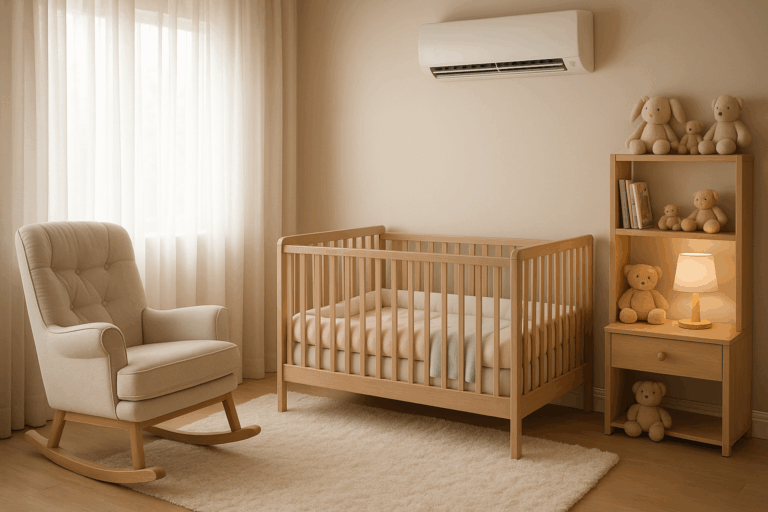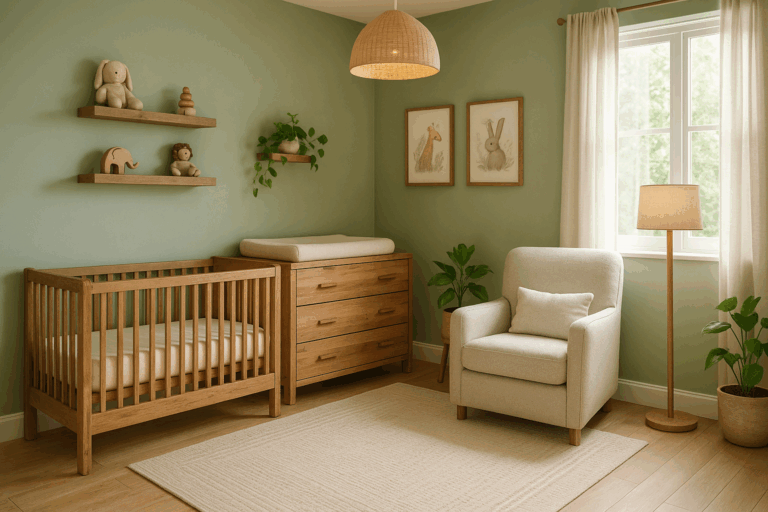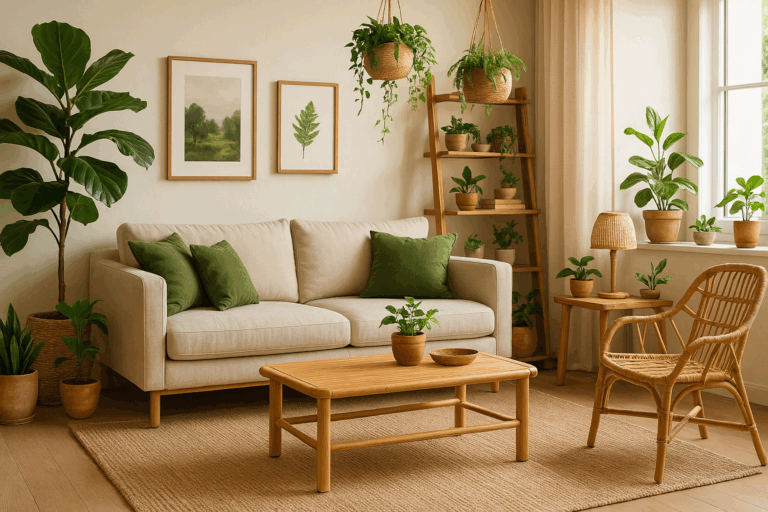💭 That’s the magic of a minimalist nursery. The understated elegance, the purposeful design, the calming ambiance – a minimalist nursery is all about simplicity that’s simply chic. This article will guide you in creating a minimalist nursery that is not just trendy and aesthetically pleasing, but also functional and perfectly tailored to your little one’s needs.
But before we delve into the specific how-tos, let’s get a clear understanding of what minimalist design truly entails. Often misconstrued as mere lack of decor or color, minimalism is, in fact, a lifestyle choice that values quality over quantity. It’s about reducing clutter, yes, but it’s also about creating a space that fosters peace, comfort, and creativity. 🌿
Why a Minimalist Nursery?
Now you might wonder, “why go minimalist for a nursery?” The answer is simple yet profound: children, especially newborns, need calm and soothing environments for their overall wellbeing. They don’t require rooms filled with toys or loud, vibrant colors. Instead, they thrive in spaces that are easy on the senses and comfortable. In a minimalist nursery, every item serves a purpose. The focus is on functionality, with aesthetics as a delightful bonus.
Key Topics to Be Discussed
So how do you get started on your minimalist nursery? Fear not, we have a comprehensive guide ready for you. In this article, we will discuss the key elements of a minimalist nursery: color schemes 🎨, furniture selection 🪑, storage solutions 📦, and decor choices 🖼️. We will also touch on the importance of safety considerations, ensuring that your minimalist nursery is not only chic but also safe for your little one.
Each section of this article will provide you with practical advice, helpful tips, and creative ideas to help you design your perfect minimalist nursery. Whether you’re starting from scratch or transforming an existing space, our guide will serve as a valuable resource in your journey.
Designing for the Future
And let’s not forget one of the significant benefits of a minimalist nursery: its timeless appeal. Minimalist spaces are designed to grow with your child. This means that the same space that cradles your infant today can seamlessly transition into a toddler’s room tomorrow, and even a teenager’s retreat in years to come. Sounds incredible, doesn’t it? 🚀 But that’s the beauty of minimalism – it’s not just about the now; it’s also about the future.
In summary, the aim of this article is not only to guide you in creating a stylish minimalist nursery, but also to help you envision a room that can evolve with your child, fostering their imagination and independence as they grow. We hope this guide will inspire you to embrace the beauty of simplicity and create a nursery that is simply chic, absolutely functional, and delightfully minimal. So let’s get started, shall we? 🛠️
Decoding the Minimalist Nursery Design: The Beauty of Simplicity
When it comes to designing a nursery for your little one, the minimalist approach has become increasingly popular. This style, rooted in simplicity and functionality, not only creates an aesthetically pleasing environment but also a peaceful and focused space for your baby. Let’s delve into the world of minimalist nursery design and learn how to create a beautiful and practical room for your precious bundle of joy.
Minimalist design is characterized by the use of clean lines, neutral color palettes, functional furniture, and a focus on space and light. This does not mean that a minimalist nursery has to be stark or boring. On the contrary, a well-designed minimalist nursery can be warm, inviting, and full of charm. The trick is to focus on quality over quantity, carefully selecting each piece for its function and aesthetic appeal.
For instance, consider a convertible crib that can grow with your child, or a dresser that can double as a changing table. Avoid the temptation to fill the room with unnecessary knick-knacks and instead choose a few well-loved toys and books to display. As Marie Kondo, the Japanese organizing consultant and author famously said, “The question of what you want to own is actually the question of how you want to live your life.”
Essential Components of a Minimalist Nursery
In order to successfully create a minimalist nursery, there are a few key components you should consider. These include:
Neutral Color Palette: Keep the color palette neutral and soothing. This will help create a calm and peaceful environment for your baby. Soft grays, pastel pinks and blues, and earth tones are all excellent choices.
Functional Furniture: Opt for furniture pieces that serve multiple purposes. For instance, a crib that converts into a toddler bed or a dresser that can be used as a changing table.
Clutter-Free Space: Keep the space free from clutter. This not only helps create a serene environment but also makes the room easier to clean and maintain.
Natural Light: Make the most of natural light. Use sheer curtains or blinds to allow light to filter into the room.
Quality Over Quantity: Invest in a few high-quality pieces instead of a multitude of cheaper items. This applies to furniture, toys, and decor items.
Remember, the goal of minimalist design is to create a space that is functional, practical, and calming. It’s about making intentional choices and focusing on the essentials.
Comparing Minimalist Nursery Designs
While the basic principles of minimalist nursery design remain the same, there is still a wide range of styles and interpretations within this category. Let’s explore some popular minimalist nursery designs and see how they differ.
Design Style
Key Features
Example
Scandinavian Minimalist
Focus on functionality, use of natural materials, neutral color palette
IKEA’s Sniglar series
Modern Minimalist
Clean lines, geometric shapes, monochrome color scheme
West Elm’s Mid-Century Convertible Crib
Rustic Minimalist
Natural materials, earthy color palette, emphasis on texture
Pottery Barn’s Kendall Crib
Boho Minimalist
Muted colors, use of natural materials, inclusion of plants
Anthropologie’s Rohini Daybed Cushion
To get a better understanding of these designs in practice, take a look at this video “Minimalist Nursery Room Ideas” by Home Art And More. It showcases different minimalist nursery designs and will certainly inspire you in creating your own.
Making the Most of Your Space
When creating a minimalist nursery, it is important to make the most of the space you have. For example, if your room is small, consider using wall-mounted shelves instead of bulky bookcases. Or, opt for a compact, convertible crib instead of a large, stand-alone one. If your room is large, resist the urge to fill it with unnecessary furniture or decor. Remember, in minimalist design, less is truly more.
Regardless of the size of your nursery, keep the layout simple and practical. Ensure there is plenty of open floor space for your baby to crawl and play. Also, consider the flow of the room. For example, keep the changing station close to the crib for easy nighttime changes, and ensure that all essentials are within easy reach.
Final Thoughts
Designing a minimalist nursery is not just about creating a beautiful room for your baby, it’s about creating a space that promotes calm, focus, and simplicity. It’s about making intentional choices and prioritizing quality over quantity.
By following the principles of minimalist design, you can create a nursery that is functional, practical, and peaceful. A place where your little one can grow and thrive.
So, are you ready to embark on your minimalist nursery design journey? Remember, it’s not about perfection, it’s about creating a space that works for you and your baby. Good luck!
ConclusionIn conclusion, it’s evident that the concepts we’ve explored in this article are indispensable in the modern-day world. We’ve dissected the intricate subject of software engineering, expounded on the latest developments in information technology, and demystified complex concepts in a manner that is both relatable and comprehensible. This deep-dive into the world of technical writing serves as a reminder of its importance in shaping how we understand, interact with, and evolve within the digital age.
From the genesis of our discussion, we underscored the essential role of software engineering in driving technological advancement. We took a closer look at how software systems are designed, implemented, and managed. In the process, we’ve come to appreciate the sophistication and precision that goes into creating the digital tools and platforms that have become so ingrained in our daily lives.
The realm of Information Technology (IT) has equally been given the limelight it deserves. Its transformative impact has been felt in virtually all sectors, from healthcare and education to finance and e-commerce. We’ve delved into the different IT trends shaping the future, such as artificial intelligence, cybersecurity, and data analytics, just to mention a few.
However, all this knowledge would be pointless if it weren’t for the art of technical writing. It is through this medium that complex subjects are broken down into digestible pieces. We’ve highlighted the importance of maintaining clarity, precision, and simplicity in technical communication. It’s also through technical writing that professionals can share their expertise and insights, fostering a culture of knowledge sharing and continuous learning.
In light of all these insights, I urge you to not just be a passive consumer of this information but to take a more active role in applying what you’ve learned. Whether you’re a software engineer, an IT specialist, or someone with a keen interest in technology, there’s something for everyone in this vast field.
As we bring our discussion to a close, I’d like to encourage you to share this article with your peers. Let’s broaden the conversation and foster a community of informed individuals who are well-equipped to navigate the future. Your comments and feedback are also highly appreciated, as they provide an opportunity for continuous learning and improvement.
As always, keep researching, keep learning, and keep pushing the boundaries of innovation. For further reading, you can visit the following resources: source.com, resource.com and reference.com. 🌐💻📘
Thank you for taking the time to read this article, and until next time, keep innovating!
Remember, knowledge is power, but it’s what you do with that power that truly makes a difference! 💪🚀🌟



